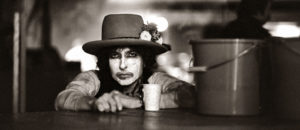It’s been quite a fortnight for Lana Del Rey. Last week, she was lauded as a “singer-songwriter laureate” and “the great American poet of the 21st century”. This week, she closed the Lollapalooza festival in the US by being physically dragged offstage.
As befits a woman who has made art out of channelling feminine archetypes, the show’s design was suitably saturated in oestrogenic imagery. The dramatic stage ejection in question was carried out while the star was recumbent on a full-length train, discarded from a wedding dress worn earlier in the set. She crooned out her first and probably still most famous hit song — the narcoleptic “Video Games” — while sitting on a giant swing covered in ribbons and flowers. Another number was sung while getting her hair and make-up fixed up onstage. There was even a scene involving a maypole. As one rapt reviewer put it: “Everything about the singer’s performance carried a delicate feminine touch that made you assured you were in safe motherly arms to feel all the emotions she conjured.”
Elsewhere this week, a much earlier version of Del Rey was also in the news. Images were discovered and gleefully circulated online of a young Lana — or Lizzy Grant, as she was before her professional name change — modelling ponchos for a knitting pattern catalogue. Fresh-faced and pink-cheeked, Lizzy cycles through some of the stock facial expressions of the catalogue model — demure, cute, proto-sultry — while gamely sporting a variety of tassel-heavy monstrosities. Though she doesn’t know it, ahead of her lies a totally distinctive musical path, a lot of kohl and back-combed hair, some astonishing songs full of rapture and disappointment, and several truly horrible takes by music critics. The pathos is palpable.
Knitting seems like a suitable metaphor for an artist’s creative trajectory — for there, too, you have to just keep going without catastrophically unravelling, until everyone can finally see what it is you were making all along. In the early stages of Del Rey’s career, barely anyone could see what the visually literate philosophy graduate with a beautiful voice was constructing.
Her sun-bleached, tearstained, drowsy West Coast sound was dismissed as pretentious pastiche. Her tremulous, dazed voice with its sensually sibilant diction — swooping from breathy to raspy to pure to the occasional throaty growl — was mocked as pitchy and inadequate. It was suggested that her act was wholly contrived by others; that she was artificially enhanced by plastic surgery; that she pretended for publicity purposes to have lived in a trailer park (she had, for a while) and her father was actually a millionaire (he wasn’t).
In his savage review of her first album Born to Die (2012), the New York Times’s reviewer began: “It’s already difficult to remember Lana Del Rey, but let’s try… That moll with the dangerous tastes in men and pastimes and the puffed-out lips and hair?… Yep, it was a pose, cut from existing, densely patterned cloth. Just like all the other poses.” The author concludes with barely suppressed triumphalism: “The only real option is to wash off that face paint, muss up that hair and try again in a few years. There are so many more names out there for the choosing.”
Luckily for us, though, Lana-who-was-once-Lizzy persisted. By the time of her album Ultraviolence (2014), with songs such as “Shades of Cool” and “West Coast”, she had perfected her persona of the somewhat sedated but still-devoted girlfriend, swooning at the recollection of kisses with beautiful boys destined to let her down. Just underneath the blank-faced, Xanax-induced composure lay a wave of archetypal female emotion and lachrymosity, surging towards whichever male with an attachment disorder currently occupied the sacred position of “my baby”.
This version of Lana adored her man, longed for him, looked after him, protected him. She was sweet, she was soft, she was all-forgiving. She got off ecstatically on the idea of herself with him, and the look of them together — his tattooed arms wrapped around her; the trappings of her own delicate femininity reflected back in the glint of his fierce eyes or the polished chrome of his motorcycle. She was even willing to pretend she didn’t care at all, just to keep him close.
To my mind, this version reached peak expression in the lushly orchestrated eponymous track of her album Honeymoon (2015), full of dramatic pauses, elongations, and mysterious, ecstatic incantations (“Dark blue… Dark blue”). By the time she languidly breathes out the climactic lines “There are violets in your eyes/There are guns that blaze around you/There are roses in between my thighs/And a fire that surrounds you”, the whole thing rivals Prokofiev’s Romeo and Juliet for tragic erotic intensity. Five years later, the singer responded angrily to a critic: “Never had a persona. Never needed one. Never will.” If this really is true, then quite frankly Del Rey must be the most stereotypically heterosexual woman who ever existed.
But this is not the stuff that critics now love her for. In fact, it’s the stuff they mostly still don’t know what to do with. On more recent albums, and particularly since Norman Fucking Rockwell! (2019), Del Rey has complicated her previous limpet-like, ride-or-die presentation. She now manifests a more conventional and modern ambivalence towards the male sex — at least, sometimes. She has also become more maternal in her styling; less pouty, more seraphically sad and queenly in bearing and glances. And you can practically hear journalists breathing a sigh of relief.
The author of a recent tribute, for instance, talks glowingly about Del Rey’s recent albums and her kinship with Bob Dylan, Sylvia Plath, and Walt Whitman (“eternally constructing and destroying the ‘I’”), but not so much about the previous self-confessed kinship with Marilyn Monroe. Her first four albums are perfunctorily dismissed as showcasing a “much more conventional pop star… whose lyrics traded in self-aware stereotypes — fuck-me-daddy, glacé-cherry, Lolita-cum-Nancy-Sinatra pastiches”. The fantasy that Lolita-cum-Nancy-Sinatra pastiches ever counted as “conventional pop” in the 21st Century — and especially during years where Beyoncé, Katy Perry, Rihanna, and Nicki Minaj were Del Rey’s main chart rivals — speaks to the difficulty, for some, of assimilating the singer’s earlier output into their narratives of world-class artistry.
Previous commentators have also struggled to place Del Rey with respect to her swaggering, bombastic, “empowered” female contemporaries, singing about how exigent they are in bed or how they insist upon paying for all their own diamonds. For some more obtuse critics, this has meant that Del Rey’s work must be “anti-feminist” and “problematic”. In 2020, the artist defensively responded to such complaints, asking that the leniency shown to peers such as Minaj and Beyonce for hits “about being sexy, wearing no clothes, fucking, cheating etc” also be shown to her for songs about “feeling beautiful by being in love even if the relationship is not perfect”. Predictably, this intervention from the star only created a further opportunity for smug chiding from female journalists about new perceived crimes — now allegedly including cultural appropriation and anti-blackness.
Yet when Del Rey covers her heroine Nina Simone’s desperate song “The Other Woman”, like Simone before her she is tapping into a well of primitive, hopeless longing that transcends skin colour. When, in “Video Games”, she tells her lover with girl-child intonation that “You the bestest” and leans in for a “big kiss”, she is channelling the thrilled shiver of a sexy young woman who knows that her short skirt attracts more wolf whistles than anything she might have to say. The singer neither validates these feelings nor criticises them, but simply gives aural expression to what they are like from the inside — enhanced in the video by carefully selected visuals, mostly directed by her and her photographer sister, that draw on a wide repertoire of feminine guises from different times and places.
And the unease of commentators in response is striking. In the sort of world they would apparently prefer, songs by women artists monotonously boasting about sexual prowess, or about grinding in clubs for money, or about cynically using some hapless fool as a sugar daddy are perfectly fine — all good clean feminist fun for seven-year-old girls to use as twerking material in TikTok videos. But songs like Del Rey’s, authentically exploring the trade-offs between the agency and passivity, pleasure and pain lurking just underneath all such superficially “empowered” poses, definitely are not.
Sometimes, journalists try to recuperate Del Rey back into the mainstream feminist fold by representing her positive cultural value as demonstrating to the world the dark side of love, the better to help us “re-focus our agenda on the cultivation of self-love”. Some even like to present her as having been on a redemptive personal journey, making much of her having eventually decided to omit in performance a song lyric originally recycled for her song “Ultraviolence” from The Crystals (“He hit me and it felt like a kiss”).
But Del Rey stands in no need of our redemption, for she has not transgressed. She has simply shown us what is the case — the ecstasy and the agony of sex, love, and loss for many women, young and not-so-young — and has transfigured it into art. She has been knitting these things together from the very beginning. We should continue to cherish this truthful messenger from the dark, tear-soaked underground of female experience — not in spite of her uncomfortably neutral presentations of unfashionable femininity, but partly because of them.
Disclaimer
Some of the posts we share are controversial and we do not necessarily agree with them in the whole extend. Sometimes we agree with the content or part of it but we do not agree with the narration or language. Nevertheless we find them somehow interesting, valuable and/or informative or we share them, because we strongly believe in freedom of speech, free press and journalism. We strongly encourage you to have a critical approach to all the content, do your own research and analysis to build your own opinion.
We would be glad to have your feedback.
Source: UnHerd Read the original article here: https://unherd.com/



